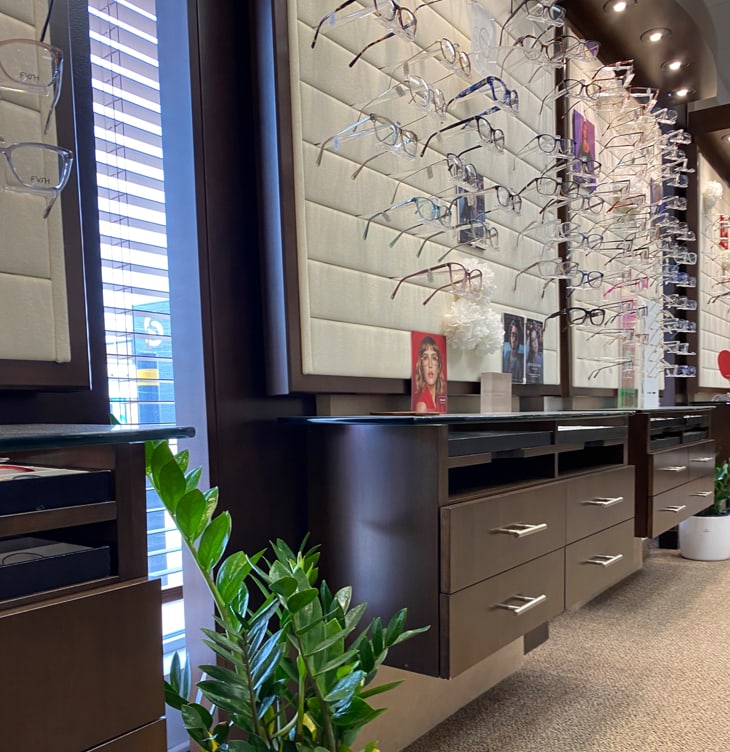Putting on a new pair of glasses for the first time can be exciting for many people. A lot of us are interested to see how our new frames will suit our faces, and others are just relieved to finally have better vision.
Almost everyone who begins wearing glasses for the first time goes through an adjustment period during which their eyes must adjust to the lenses and their faces to the frames. If you’re experiencing mild discomfort, vision blurriness, or headaches, these are all common symptoms.
While the process can be frustrating, knowing how to deal with these changes can help you transition to life with better vision. Continue reading to learn how to make the adjustment period as smooth as possible.
Having Headaches is Normal
Unfortunately, headaches and nausea are common when wearing new glasses. Frames can cause pressure on your nose and temples, resulting in a tension headache.
Sight is directly controlled by the brain, which becomes overwhelmed by all of these new visual stimuli and requires some time to adapt. It’s the same as breaking in a new pair of shoes, you have to break them in before they adapt to your feet. You’ll have this dizzy, uncomfortable spell every time you update your lenses if your prescription changes.
Wear Your Glasses Every Day
It might seem like an obvious solution, but it does take some effort to develop a habit of wearing your new glasses every day, especially if you’ve never worn them before. Even if they’re uncomfortable, continue to wear them daily.
Take breaks when you feel dizzy, but try to put them back on and continue with your day. However, if you are experiencing eye pain or severe headaches, you should consult your eye doctor to ensure that everything is okay.
Keep Your Glasses Clean
Your lenses should alleviate the strain on your eyes. If your lenses are cloudy, smudged, or otherwise dirty it creates more strain. To keep your lenses clean, use a microfiber lens cloth or a spray lens cleaner to remove the most stubborn dirt.
Exercise Your Eyes
If you suffer from eye strain, especially while wearing glasses at work, a few simple eye exercises may help. Take your gaze away from your computer screen and desk every hour or so to focus on something far away in the distance, such as a tree or building outside your window.
Next, look down and focus on something close, then alternate between focusing on objects at various distances. This exercise is especially beneficial when learning how to adapt to bifocals or progressive lenses.
Make Small Adjustments
As your brain learns to interpret the visual world through your new lenses, you may feel dizzy or nauseous. This can happen when your brain is trying to keep up with your eyes as they move from one object to the next. The sensation may cause you to feel as if you are constantly moving.
Dizziness and nausea are also common with new bifocal lenses, which combine prescriptions for close-up work and distance viewing in a single lens. The same thing can happen with progressive lenses, which combine prescriptions for close-up work, distance viewing, and computer work. As you switch between prescriptions, your brain must quickly recalculate.
To avoid dizziness as you adjust to these lenses, try turning your head toward the object you want to see rather than moving your eyes toward it. Take extra care when walking down steps until your eyes adjust to your bifocal or progressive lenses.
Monitor Your Stress Levels
If you are under a lot of stress or are anxious, this can affect your vision. You may not blink as frequently, causing your eyes to dry out. You may unknowingly open your eyes wider or look around more frequently, which can cause muscle strain.
This causes eye strain and fatigue, which can lead to short-term vision impairment. During the day, take some time to relax with your glasses on.
Protect Your Frames
In addition to cleaning and protecting your glasses with appropriate cloths, you should keep them safe in a hard-shelled case, especially if you carry them with you. The lenses may not line up properly with your eyes if the frames warp or are not properly adjusted to your face.
Each lens has a centre of focus that is determined by where your pupil is located, and if this isn’t aligned properly, your vision may not be corrected.
Be Patient with Your New Glasses
Your eyes may take up to two weeks to adjust to your first pair of glasses. If you’re frustrated by discomfort or other symptoms, don’t give up and stop wearing your glasses. This will lengthen the period of adjustment.
If you’re worried about the fit or prescription of your new glasses, book an appointment with us today so we can ensure the most suitable fit possible.











